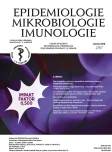Bacteremia due to Staphylococcus aureus – the importance of appropriate management
Authors:
S. Arientová 1; O. Beran 1; M. Štefan 1; M. Čurdová 2; M. Holub 1
Authors‘ workplace:
Klinika infekčních nemocí, 1. lékařská fakulta, Univerzita Karlova a Ústřední vojenská nemocnice – Vojenská fakultní nemocnice Praha
1; Oddělení klinické mikrobiologie, Ústřední vojenská nemocnice – Vojenská fakultní nemocnice Praha
2
Published in:
Epidemiol. Mikrobiol. Imunol. 67, 2018, č. 2, s. 88-91
Category:
Short Communication
Overview
Staphylococcus aureus bacteremia (SAB) is the most common cause of severe bloodstream infections with high incidence and lethality. The diagnosis of SAB must be followed by an appropriate diagnostic and therapeutic management. The aim of the study was to identify clinical and epidemiological characteristics of SAB cases treated in the Central Military Hospital Prague and to assess compliance with the guidelines for diagnosis and therapy. A total of 65 patients with S. aureus blood culture positivity were enrolled in the retrospective study. Sixty SAB cases (92%) were caused by MSSA strains, and MRSA strains were detected in five patients (8%). The source of the infection was confirmed in 83% of patients. The average case fatality rate in the study cohort was 28%. The analysis of the quality of care suggested both diagnostic and therapeutic insufficiencies in 65% of SAB patients. Overall, the result of the study supports the importance of the role of infectious disease specialists played in the bedside management of patients with SAB.
Keywords:
Staphylococcus aureus – staphylococcal infections – bacteremia
Sources
1. Tong SY, Davis JS, Eichenberger E, et al. Staphylococcus aureus infections: epidemiology, pathophysiology, clinical manifestations, and management. Clin Microbiol Rev, 2015;28(3):603–661.
2. van Hal SJ, Jensen SO, Vaska VL, et al. Predictors of mortality in Staphylococcus aureus Bacteremia. Clin Microbiol Rev, 2012;25(2):362–386.
3. Naber CK. Staphylococcus aureus bacteremia: epidemiology, pathophysiology, and management strategies. Clin Infect Dis, 2009;48 Suppl 4:S231–237.
4. Cosgrove SE, Sakoulas G, Perencevich EN, et al. Comparison of mortality associated with methicillin-resistant and methicillin-susceptible Staphylococcus aureus bacteremia: a meta-analysis. Clin Infect Dis, 2003;36(1):53–59.
5. Anantha RV, Jegatheswaran J, Pepe DL, et al. Risk factors for mortality among patients with Staphylococcus aureus bacteremia: a single-centre retrospective cohort study. CMAJ Open, 2014;2:E352–359.
6. Le Moing V, Alla F, Doco-Lecompte T, et al. Staphylococcus aureus Bloodstream Infection and Endocarditis-A Prospective Cohort Study. PLoS One, 2015;10(5):e0127385.
7. Vogel M, Schmitz RP, Hagel S, et al. Infectious disease consultation for Staphylococcus aureus bacteremia – A systematic review and meta-analysis. J Infect, 2016;72(1):19–28.
8. Martin L, Harris MT, Brooks A, et al. Management and outcomes in patients with Staphylococcus aureus bacteremia after implementation of mandatory infectious diseases consult: a before/after study. BMC Infect Dis, 2015;15 : 568.
9. European Centre for Disease Prevention and Control (ECDC) [online]. Antimicrobial resistance surveillance in Europe 2015. Stockholm: 2017. Dostupný na www: <http://ecdc.europa.eu/en/healthtopics/antimicrobial-resistance-and-consumption/antimicrobial_resistance/EARS-Net/Pages/EARS-Net.aspx>. ISBN 978-92-9498-029-8.
10. Lopez-Cortes LE, Del Toro MD, Galvez-Acebal J, et al. Impact of an evidence-based bundle intervention in the quality-of-care management and outcome of Staphylococcus aureus bacteremia. Clin Infect Dis, 2013;57(9):1225–1233.
Labels
Hygiene and epidemiology Medical virology Clinical microbiologyArticle was published in
Epidemiology, Microbiology, Immunology

2018 Issue 2
Most read in this issue
- Streptococcal toxic shock syndrome – a life-threatening condition caused by various streptococcal species
- Bacteremia due to Staphylococcus aureus – the importance of appropriate management
- Fight against antimicrobial resistance
- Updated Czech guidelines for the laboratory diagnosis of Clostridium difficile infections
